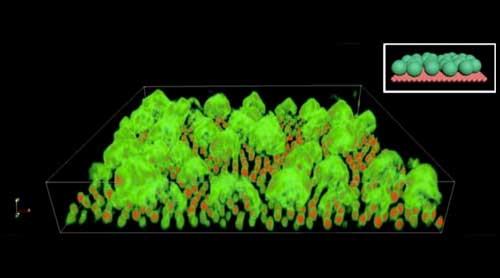| Dec 10, 2019 | |
Tiny crystals work better when they double up with designer frameworks(Nanowerk News) Where two unusual materials meet, scientists have seen promising behaviors for energy storage, medicine, and more. The materials are ultra-small crystals and molecular cages. But getting the most out of these materials is difficult because scientists couldn’t precisely arrange the crystals and cages. |
|
| An international team of users and Foundry staff overcame that challenge. They wrote a set of design rules that they then used to direct the self-assembly of the crystals and the cages into new types sheet-like structures (Angewandte Chemie International Edition, "Design rules for self-assembly of 2D nanocrystal/metal–organic framework superstructures"). | |
 |
|
| Researchers discovered that iron-oxide nanocrystals (red) and metal-organic frameworks (green) self-assemble into an unusual configuration that resembles a Chinese pastry. The inset (upper right) mimics the transmission electron microscopy image. (Image: Berkeley Lab) | |
| This is the first time that researchers have guided the self-assembly of organized sheet-like structures using nanocrystals and molecular cages. The cages are metal-organic frameworks (MOFs). Knowing the design guides will enable new materials. These materials could improve catalysts, energy storage, biomedicine, and more. | |
| Many types of catalytic, chemical conversion, or energy storage processes have been observed at the interface between MOFs and nanocrystals, but most of the existing work has relied on poorly controlled aggregates or bulk powders without stable or controllable structures. | |
| It would be incredibly desirable to be able to precisely control the arrangement and spatial co-localization of MOFs and nanocrystals, but co–self-assembly of these has proven very challenging. | |
| This international research team of users and Foundry staff performed fundamental physical studies of the energetics of MOF self-assembly and determined a set of design rules that they then used to direct the first self-assembly of organized, binary, superlattice structures made of MOFs and nanocrystals. | |
| Experimental observations, along with theoretical modeling and simulations, have enabled a more in-depth understanding of these complicated self-assembly processes. The engineering of nanoparticles into self-assembled superstructures will open new technological applications in electronics, optics, catalysis, and biomedicine. |
| Source: Lawrence Berkeley National Laboratory | |
|
Subscribe to a free copy of one of our daily Nanowerk Newsletter Email Digests with a compilation of all of the day's news. |
